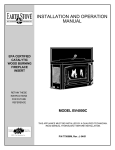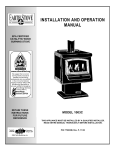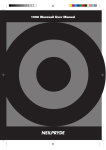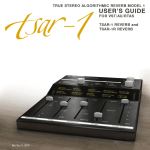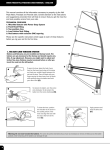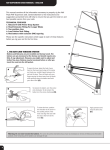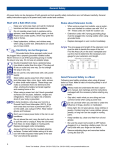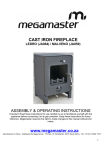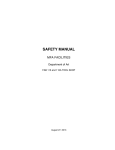Download Pure Power Tools CIRCULAR SAW Operator`s manual
Transcript
General Safety All power tools can be dangerous if both general and tool specific safety instructions are not followed carefully. General safety instructions apply to all power tools, both corded and cordless. Start with a Safe Work Area Keep your work area clean and well lit. Cluttered benches and dark areas invite accidents. Do not operate power tools in explosive atmospheres, near flammable liquids, gases, or dust. Power tools create sparks, which may ignite the dust or fumes. • Keep bystanders, children, and visitors away when using a power tool. Distractions can cause you to lose control. Electricity can be Dangerous Grounded tools (three pronged cords) must be plugged into a properly grounded installed outlet. Never remove or cut off the grounding prong or modify the plug in any way. Do not use any adapter plugs. Double Insulated tools have a polarized plug (one blade is wider than the other.) This plug will fit into an outlet only one way. Do not change the plug in any way. Do not use AC only rated tools with a DC power supply. Store battery packs away from other metal objects like paper clips, coins, keys, nails, screws, or other small metal objects. These things can make a connection from one terminal to the other, shorting the battery terminals together and causing burns or fire. • When using a power tool, don’t touch grounded surfaces such as pipes, radiators, ranges and refrigerators. There is a higher risk of electric shock if your body is grounded. In damp locations, only plug your tool into a Ground Fault Circuit Interrupter (GFCI). If the work area does not have a permanent GFCI on the outlet, use a plug-in GFCI. Wear rubber gloves and footwear. Don’t use or leave power tools in the rain or wet conditions. Do not abuse the cord, carry the tool by its cord, or pull the cord to unplug it. Keep the cord away from heat, oil, sharp edges or moving parts. Replace damaged cords immediately. Always hold the tool by the insulated gripping surfaces. Contact with hidden wiring or its own cord will make exposed metal parts of the tool “live” and shock the operator. Rules about Extension Cords • When using a power tool outside, use an extension cord marked for outdoor use with “W-A” or “W”. These cords are made for outdoor use. • Extension cords with 3-prong grounding plugs must be plugged into 3-prong outlets when using grounded tools. • Replace damaged or worn cords immediately. The wire gauge and length of the extension cord must be able to handle the amps of the tool. Find the Amps (A) on the tool’s nameplate and use the chart to determine the necessary wire gauge for your extension cord length. 16 16 16 12 Good Personal Safety is a Must Following good safety practices when using all power tools is a must. Make a habit of including safety in all of your activities. Always read and understand the tool’s operator’s manual, tool markings and the instructions packaged with the accessory before starting any work. • Stay alert, watch what you are doing and use common sense when using a power tool. Do not use tools when you are tired or under the influence of drugs, alcohol, or medication. • Dress right. Do not wear gloves, loose clothes or jewelry. Contain long hair. Loose clothes, gloves, jewelry, or long hair can be caught in moving parts. • Keep handles dry, clean and free from oil and grease. • Be sure the power tool’s switch is OFF before plugging it in or inserting a battery pack. Do not carry tools with your finger on the switch. Remove adjusting keys and wrenches before turning the tool ON. 4 Power Tool Institute | Phone: 216-241-7333 | Fax: 216-241-0105 | www.powertoolinstitute.com • Always keep a firm footing when using power tools. Be sure you have balance and control before you start the job. Use safety equipment. Always wear eye protection. A dust mask, non-skid safety shoes, hard hat, or hearing protection must be used when needed. The reference to “safety goggles” or “safety glasses” in product specific sections provides potential options - always refer to the tool’s operator’s manual for the specific eye protection recommended, which should be marked as complying with current national standards. • Unplug tool/remove battery before changing accessories. Keep hands away from rotating or moving parts. Do the Job Safely • Use the power tool accessories only for the jobs for which they were designed. Secure and support the workpiece. Use clamps and a stable work surface. Do not hold the work by hand or against your body. • Keep guards in place and working properly. • Do not force the tool. Use the right tool for your job. It will do the job better and safer. • Use only accessories recommended by the tool manufacturer. Accessories that may be suitable for one tool may become hazardous when used on another tool. Do not touch the drill bit, blade, cutter or the workpiece immediately after operation; they may be very hot and may burn you. • If a method of dust collection is available with the power tool, it should be used to reduce the risk of dust-related hazards. Maintenance Keeps Tools Working Safely and Effectively • Do not use a tool if the switch does not turn it on and off. It must be repaired. Look at the tool before using it. Are moving parts misaligned or binding? Is anything broken? Damaged tools must be fixed before using them. Develop a maintenance schedule for your tool. • Maintain accessories carefully. Keep blades and bits sharp and clean. • Take your tool to be serviced by qualified repair people. Service or maintenance performed by unqualified personnel could result in a risk of injury. For example: internal wires may be misplaced or pinched, safety guard return springs may be improperly mounted. • When servicing a tool, use only identical replacement parts. Follow instructions regarding maintenance in the tool’s operator’s manual. Use of unauthorized parts or failure to follow the maintenance instructions may create a risk of electric shock or injury. • Clean and lubricate a tool only as directed in its operator’s manuals. Certain cleaning agents such as gasoline, carbon tetrachloride, ammonia, etc. may damage plastic parts. • Maintain labels and nameplates. These carry important information. If unreadable or missing, contact the manufacturer for a replacement. When Done, Store the Tools out of Harm’s Way To avoid accidental starting, unplug the cord, remove batteries or lock off the switch when the tool is not being used, when changing accessories, and when adjusting or cleaning tools. • Keep tools out of the reach of children and people unfamiliar with the tools. 5 Power Tool Institute | Phone: 216-241-7333 | Fax: 216-241-0105 | www.powertoolinstitute.com Circular Saws Among professional tradesmen, on the farm, around the house and in the vocational shop, the circular saw is probably the most commonly used power saw and perhaps the most commonly abused. Familiarity should not lead to carelessness. The following are specific safety ‘musts’ when using any portable circular saw. Failure to follow these safety rules can result in serious injury. Good Personal Safety is a Must Know your Workpiece Following good safety practices when using circular saws is a must. Make a habit of including safety in all your activities. Take time to review your work and make sure that all necessary precautions have been taken before making a cut. Circular saws are used to cut a variety of materials, each having its own specific setup requirements. Always read and understand the tool’s operator’s manual, tool markings and the instructions packaged with the accessory before starting any work. Always wear safety goggles or safety glasses with side shields complying with current national standards, and a full face shield when needed. Use the appropriate mask or respirator in dusty work conditions. • Wear proper hearing protection, as needed. • Dress right. Do not wear gloves, loose clothes or jewelry. Contain long hair. Loose clothes, gloves, jewelry, or long hair can be caught in moving parts. • Crowded, cluttered work areas that can cause tripping or loss of balance are particularly dangerous. Choose the Right Tool and Blade Choosing the correct tool and the proper saw blade for your application can help to reduce the risk of serious injury. When used according to the manufacturer’s instructions, the proper tool and accessory will do the job safer and faster. • Do not use a circular saw that is too heavy for you to easily control. Use sharp blades. Damaged or dull blades could throw teeth, posing a serious injury risk. A sharp blade will tend to cut its way out of a pinching condition. Use the correct blade for your tool. Check this carefully: Does it have the proper size and shape arbor hole? Make sure the speed marked on the blade is at least as high as the no load RPM marked on the tool. • Use clean saw blades. A buildup of pitch or sap on the surface of the saw blade increases blade thickness and also increases blade friction and the likelihood of kickback. Know what is behind a workpiece before you do the job. Do not cut into existing walls or other blind areas where electrical wiring, water, or gas pipes may exist. If this situation is unavoidable, disconnect all fuses/circuit breakers, and shut off any water and gas lines feeding this work site. • Support large panels (as illustrated) so they will not pinch the blade. • Use a straight edge or rip fence as a guide for ripping. • Avoid cutting small workpieces that can’t be properly secured, and workpieces on which the base of the saw (shoe) can not properly rest. Injury could result from small pieces being thrown back at the operator if the blade pinches and binds. Portable circular saws are not designed for cutting logs, roots, trimming trees or shrubs. Be very cautious of stock which is pitchy, knotty or warped. These are most likely to create pinching conditions and possible kickback. Before Cutting... Before working with a circular saw, make sure the tool and its accessories are in proper working order. Failure to do so can increase your risk of injury and result in blade pinching, binding or stalling, kickback and loss of control. These situations can cause the saw to jump back at the operator and result in a serious injury. Check blades carefully before each use for proper alignment and possible defects. Never use a bent, broken or warped saw blade. • Make sure the blade has adequate blade set. Blade set provides clearance between the sides of the blade and the workpiece, thus minimizing the probability of binding. Some saw blades have hollow ground sides instead of blade set to provide clearance. 11 Power Tool Institute | Phone: 216-241-7333 | Fax: 216-241-0105 | www.powertoolinstitute.com • Be sure the blade flanges (washers) or bolt are correctly assembled on the shaft and installed in accordance with the tool manufactuer’s instructions. • Never hold a workpiece in your hand or across your leg when sawing. • Check for proper blade guard operation before each cut. Never use a tool with a guard missing. The guards should return to their normal position quickly. If a guard seems slow to return or “hangs up”, repair or adjust it immediately. Never alter or defeat the guard (e.g., tying back or removing the guard). Keep hands and body away from and to the side of the blade. Contact with blade will result in serious injury. • The lower guard should be pulled back manually only for special cuts such as “Pocket Cuts” and “Compound Cuts”. Raise the lower guard using the lower guard lever. As soon as blade enters the material, release the lower guard. • Be sure the tool switch works properly. Do not use a tool if the switch does not turn it off when returned to the off position. • Tighten depth and bevel levers securely. While Cutting … Concentrate on what you are doing and be aware of kickback (a sudden reaction to a pinched, bound or misaligned blade). Kickback can cause an uncontrolled tool to lift up and out of the workpiece toward the operator and is the result of tool misuse and/or incorrect operating procedures or conditions. Take these specific precautions to help prevent kickback when using any type of circular saw: Before starting a circular saw, be sure the power cord and extension cord are out of the blade path and are long enough to freely complete the cut. A sudden jerk or pull on the cord can cause loss of control of the saw and a serious accident. Clamp workpieces securely. Check frequently to be sure clamps remain secure. A moving workpiece can cause loss of control and result in injury. NEVER overreach! Always, hold the saw firmly with both hands after securing the workpiece. • Set blade depth to no more than 1/8 in. to 1/4 in. greater than the thickness of the material being cut. Less than a full tooth should be visible below the workpiece. • Minimize blade pinching by placing the saw shoe on the clamped, supported portion of the workpiece, and allowing the cut off piece to fall away freely. • When you start your saw allow the blade to reach full speed before contacting the workpiece. Be alert to the possibility of the blade binding and kickback occurring. Hold the saw with two hands and position your arms to resist kickback. If a fence or guide board is used, be certain the blade is kept parallel with it. • Never remove the saw from a cut while the blade is rotating. When making a partial cut, or if power is interrupted, release the switch immediately and don’t remove the saw from the workpiece until the blade has come to a complete stop. Removing the saw with a rotating blade could result in a saw tooth grabbing the workpiece, causing loss of control. Never reach under the saw or workpiece. The blade is exposed under the workpiece and the saw guard cannot protect your body here. • Release the switch immediately if the blade binds or the saw stalls. • When restarting a saw in the workpiece, center the saw blade in the kerf and check that saw teeth are not touching the material when the saw is turned on. • Turn off the tool after a cut is completed and keep the saw away from your body until the blade stops. The blade may coast for a time, posing the risk of serious cuts. Overheating a saw blade can cause it to warp and result in kickback. Buildup of sap on the blades, insufficient blade set, dullness, and unguided cuts, can all cause an overheated blade and kickback. 12 Power Tool Institute | Phone: 216-241-7333 | Fax: 216-241-0105 | www.powertoolinstitute.com When Done... Unplug, clean and store the tool in a safe, dry place after use. Always Remember… Wear safety glasses Tighten depth levers securely Grip saw with both hands, keeping hands away from the blade. No loose clothing Set the depth of cut 1/8” to 1/4” greater than the thickness of the stock Secure the workpiece to sturdy supports Always rest the larger portion of the saw’s baseplate on the supported portion of the workpiece. Allow the unsupported portion to fall away. Keep the cord away from the blade and kerf. Firm footing in a clean area 13 Power Tool Institute | Phone: 216-241-7333 | Fax: 216-241-0105 | www.powertoolinstitute.com






